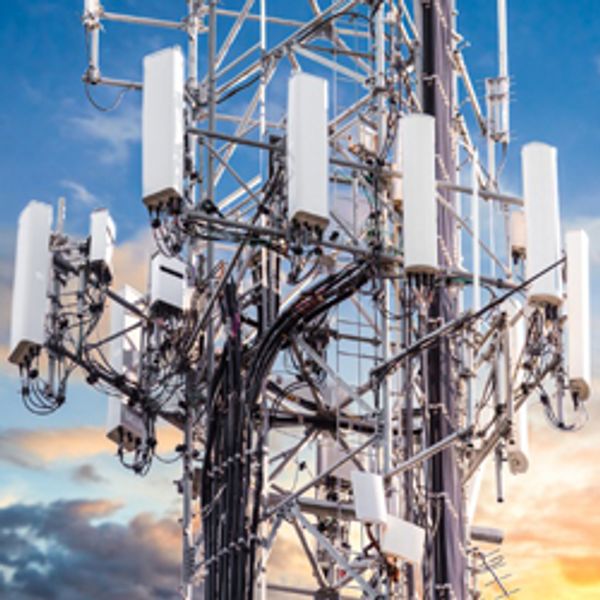The 5G Revolution is Changing Logistics.
The gains in supply chain performance are limitless

The fifth generation of mobile phone networks, commonly known as 5G, has arrived, and the list of cities with 5G access continues to grow. According to the 2022 Annual Third-Party Logistics Study, 5G is designed to provide comprehensive connectivity among virtually everyone and everything, including machines, objects and devices, enabling users to move more significant amounts of data more quickly. As a result, it should enhance supply chain operations, performance and real-time communications, ultimately driving the digital supply chain.
Multifaceted Innovation
5G is not a single technological innovation, but a combination of advances in various areas — including core network capacity, connectivity, cell tower design, radio bandwidth, and all the devices that plug into the new generation of networks.
It’s a powerful package. An overarching objective is to deliver internet connections that are at least 40 times faster than those available using existing 4G wireless communications. Users will be able to download huge volumes of data much faster. Moreover, 5G’s wider bandwidth improves users’ ability to exchange complex data sets from multiple sources. Query response times will be faster because network latency — the time required to transmit a set of data between parties — is much reduced with 5G. And the technology is more versatile than 4G, in that 5G incorporates advanced “network slicing” which enables mobile devices to connect to multiple networks simultaneously.
The technology’s reach is growing rapidly. Research firm Gartner Inc. said 5G is the fastest growing segment in the wireless network infrastructure market. Gartner forecasts that worldwide 5G network infrastructure revenue will reach $23.3 billion in 2022, up from $19.1 in 2021. Gartner also estimates that 60% of communication service providers will provide commercialized 5G services by the end of 2024.
An Ongoing Story
As the importance of information technology to the effective functioning of supply chains continues to accelerate, the capabilities of 5G and IoT will help immensely with objectives relating to supply chain transparency, visibility and collaboration, but where are we likely to see 5G applications?
“We see it happening initially in distribution and warehousing,” says Dave Bushee, senior vice president of logistics technology for Penske Logistics.
In the warehousing space, “facilities in large metropolitan areas will have access to three levels of 5G, and this will speed up warehouse implementations,” Bushee says. The more powerful wireless infrastructure will eliminate much of the traditional circuitry that warehouses need to operate, and will improve connectivity to warehouse management systems, he explains.
Another warehouse-related area where 5G will have a significant impact is in the application of augmented reality (AR) technology. Instant updates of cargo movements will enhance the performance of AR devices, enabling managers to reduce order-picking error rates and enhance workforce productivity. Also, 5G-powered assembly and repair processes in warehouses will become faster as transmissions to AR-enabled devices speed up. For example, hands-free AR glasses will display step-by-step instructions for assembly and repair work in real time, reducing both the amount of training time staff require and manpower costs.
Other notable applications of 5G in logistics include:
Lower connectivity barriers for IoT devices. By reducing the power requirements for sensors, 5G will likely trigger an increase in the number of sensing devices deployed as well as their range of capabilities. 5G is a key enabler of a $1.9 trillion logistics market for IoT-based sensor networks.
Support for smart cities. The movement to wire cities with sensors is well underway, and 5G will play a central role as the technology matures. Cities such as Atlanta, Las Vegas, and Kansas City have installed networks of sensors to operate lighting systems and monitor traffic flows.
Enhanced analytics. 5G-powered networks will exchange higher volumes of complex data sets faster than is currently possible, and this will drive more sophisticated supply chain analytics.
Better freight management. Improvements in supply chain visibility and network communications will make the management of transportation fleets more efficient. Notable applications include the development of autonomous trucks and drones as well as inter-vehicle communications.
A Digitalized Future
While 5G-powered mobile networks are on a fast growth track, there are some challenges to overcome. For example, a massive increase in the number of IoT- connected devices will create an urgent need for new scheduling and access control systems for users. Providers and users also have to focus on network security and data privacy issues.
However, 5G is forecast to become the lead network technology in the U.S. by 2025, with more than 190 million mobile connections. Moreover, as the technology evolves, it will open new avenues for innovation. Market-leading logistics service providers such as Penske Logistics are playing a critical role in bringing 5G to the supply chain community, and helping companies to capture its benefits. Importantly, Penske also is actively involved in integrating 5G into the digitalization of supply chains.
As 5G continues to advance, the potential gains in supply chain performance are limitless.
